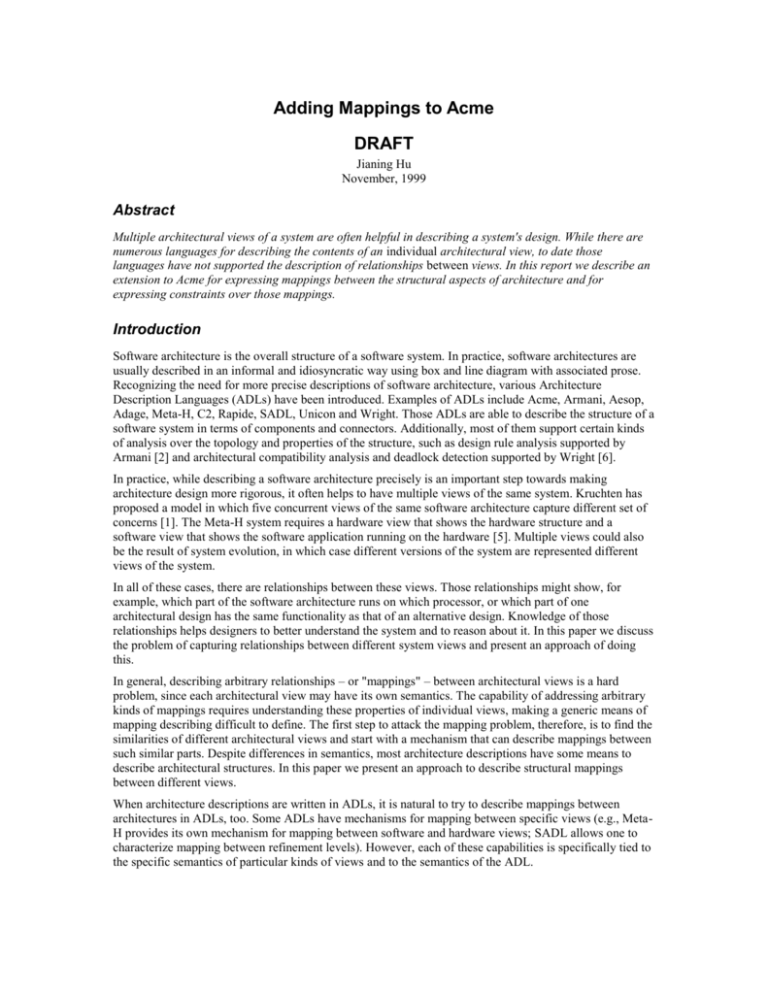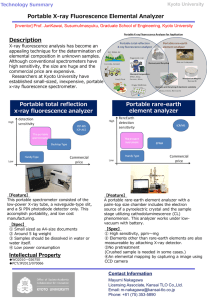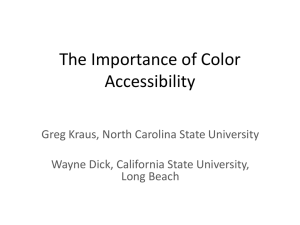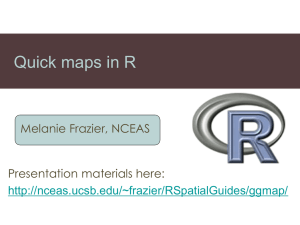Preliminary proposal for the mapping extension
advertisement

Adding Mappings to Acme
DRAFT
Jianing Hu
November, 1999
Abstract
Multiple architectural views of a system are often helpful in describing a system's design. While there are
numerous languages for describing the contents of an individual architectural view, to date those
languages have not supported the description of relationships between views. In this report we describe an
extension to Acme for expressing mappings between the structural aspects of architecture and for
expressing constraints over those mappings.
Introduction
Software architecture is the overall structure of a software system. In practice, software architectures are
usually described in an informal and idiosyncratic way using box and line diagram with associated prose.
Recognizing the need for more precise descriptions of software architecture, various Architecture
Description Languages (ADLs) have been introduced. Examples of ADLs include Acme, Armani, Aesop,
Adage, Meta-H, C2, Rapide, SADL, Unicon and Wright. Those ADLs are able to describe the structure of a
software system in terms of components and connectors. Additionally, most of them support certain kinds
of analysis over the topology and properties of the structure, such as design rule analysis supported by
Armani [2] and architectural compatibility analysis and deadlock detection supported by Wright [6].
In practice, while describing a software architecture precisely is an important step towards making
architecture design more rigorous, it often helps to have multiple views of the same system. Kruchten has
proposed a model in which five concurrent views of the same software architecture capture different set of
concerns [1]. The Meta-H system requires a hardware view that shows the hardware structure and a
software view that shows the software application running on the hardware [5]. Multiple views could also
be the result of system evolution, in which case different versions of the system are represented different
views of the system.
In all of these cases, there are relationships between these views. Those relationships might show, for
example, which part of the software architecture runs on which processor, or which part of one
architectural design has the same functionality as that of an alternative design. Knowledge of those
relationships helps designers to better understand the system and to reason about it. In this paper we discuss
the problem of capturing relationships between different system views and present an approach of doing
this.
In general, describing arbitrary relationships – or "mappings" – between architectural views is a hard
problem, since each architectural view may have its own semantics. The capability of addressing arbitrary
kinds of mappings requires understanding these properties of individual views, making a generic means of
mapping describing difficult to define. The first step to attack the mapping problem, therefore, is to find the
similarities of different architectural views and start with a mechanism that can describe mappings between
such similar parts. Despite differences in semantics, most architecture descriptions have some means to
describe architectural structures. In this paper we present an approach to describe structural mappings
between different views.
When architecture descriptions are written in ADLs, it is natural to try to describe mappings between
architectures in ADLs, too. Some ADLs have mechanisms for mapping between specific views (e.g., MetaH provides its own mechanism for mapping between software and hardware views; SADL allows one to
characterize mapping between refinement levels). However, each of these capabilities is specifically tied to
the specific semantics of particular kinds of views and to the semantics of the ADL.
In this paper we propose a different approach. Instead of ADL specific views, we consider the general
problem of mapping between architectural structures. Specifically, we show how to add an extension of
structural mapping (and mapping types) to ACME, a generic language for characterizing architectural
structures.
The goal is to permit the view specifier to identify classes of mapping, based on the types of structure and
constructs and their relationships. Mappings between specific architecture descriptions are the instances of
these classes and can be checked for constraining. This work can be viewed as a first step towards
supporting multiple views in software architecture by focusing primarily on flexible relationships between
structural elements.
Requirements
If we treat the problem of describing architectural views as one in which we extend existing ADLs with
mapping constructs, then there are some natural requirements that we would like the extension to satisfy.
These are:
Expressive power; The extension should be able to describe a wide variety of mappings. In particular,
in the context of structural mappings, our extension should allow mappings between arbitrary number
and types of structural elements.
Support of mapping classification and reuse. The extension should support classification of
mappings. It should also allow the user to build a mapping on top of an existing mapping description,
thus reuse the existing description.
Analyzability; There are various kinds of constraints that the specifier might want a mapping to
satisfy. The constraints could be a certain type that the mapping should satisfy, or relationships
between view properties, etc. Our extension should support formal notations for such constraints,
which can therefore be formally checked for validity.
Background of Acme
Acme is a simple, generic ADL that was designed to be an interchange format of architectural description.
To support interchanging, ACME describes an architectural design as a hierarchical collection of
interacting components, which is agreed by all ADLs. In particular, ACME uses seven constructs to specify
an architecture – components, connectors, ports, roles, systems, representations, and rep-maps. Besides
providing a common infrastructure for describing architectural structures, ACME also provides a flexible
annotation mechanism supporting association of non-structural information using externally defined
languages. One of such languages is Armani, a predicate language that can be used to describe invariants
and heuristics. Armani’s ability of declaring invariants and heuristics is especially useful for our extension,
since it can be used to declare the constraints or consistency statement that we want mappings to satisfy.
There are several advantages using ACME as the basis of our extension. First, ACME was designed as an
interchange language, therefore it focus on the essential issues of architectural description like structure.
Also, as an interchange language, it is in some sense the least common denominator of a large family of
ADLs. Therefore the extension of Acme can be effectively employed by other ADLs.
Overview of Approach
Sys1
Character
Stream
Lexical
Analyzer
Tokens
Parser
AST
Code
Abstract
Syntax
Tree
Sys2
Read
Write
Character
Stream
Code
Generator
Lexical
Analyzer
Tokens
Parser
Ordering
Code
Generator
Code
dataflow connector
functional component
controlflow connector
shared memory component
read/write connector
Figure1: Two architectures for a compiler
To illustrate our approach, consider two views of a design of the architecture for a compiler. An abstract
pipe-and-filter architecture is depicted at the top of Figure 11 as Sys1. A more concrete (i.e.,
implementation-oriented) architecture that is a hybrid of pipe-and-filter and shared-memory styles is shown
at the bottom of Figure 1 as Sys2. A complete declaration of Sys1 and Sys2 in Acme can be found in
appendix A.
As a refinement of Sys1, Sys2 has much in common with Sys1. For example, intuitively we would expect
the functional components in Sys2 to be the "same" as their corresponding components in Sys1. The
similarity could include comparable functionality and equal throughput, etc.
Figure 2 shows how we might indicate this intuitive correspondence more formally as a mapping 2. In this
declaration "same" is the name of this mapping. In the brackets ("{}") is the mapping body, which consists
of pairs of elements that are associated by this mapping. Each of these pairs is called a maplet 3.
Map same with {
Sys1.analyzer to Sys2.analyzer;
Sys1.parser to Sys2.parser;
Sys1.generator to Sys2.generator;
}
Figure 2
1
The two architectures shown in Figure 1 are a simplified version of the example used in [7].
In this paper, bold in declarations indicates keywords unless otherwise stated.
3
As we will see later, a maplet could consist of more than just the pair of elements.
2
Figure 2 declares a mapping between functional components of Sys1 and Sys2, with each maplet
connecting two components that have the “same” functionality. It is not as straightforward, however, to
declare a mapping between connectors of the two architectures on the same basis. Though it is not hard to
find Sys1.Token’s functional correspondence in Sys2, there is no single component or connector in Sys2 that
takes the same responsibility as Sys1.AST does. Sys1.AST’s responsibility is to transmit data and control
flow from Sys1.Analyzer to Sys1.Generator. In Sys2, the same responsibility is carried by Sys2.write,
Sys2.ast, Sys2.read, and Sys2.Ordering together. To address the aggregation of these elements as a whole,
we introduced compound types. There are three kinds of compound types, set, sequence, and record. A set
is an unordered list of elements. A sequence is an ordered list of elements. A record is a tuple of elements,
each of which has a name. In this case we can denote the aggregation of elements as a record. The mapping
declaration is shown in figure 3.
Map pipe2channel with {
Sys1.ast to [ from = Sys2.write,
through = Sys2.ast,
dest = Sys2.read
control = Sys2.Ordering];
}
Figure 3
Sometimes mappings between structures might indicate mappings between sub-structures. For example, in
Figure 1, the "same" mapping between Sys1.analyzer and Sys2.analyzer might indicate a certain
relationship between the ports Sys1.analyzer.output and Sys2.analyzer.output. To support the declaration of
such "sub relations", hereafter referred to as "nested mappings", we allow hierarchical mapping
declarations. An example of nested mapping is shown in figure 4.
Map same with {
Sys1.analyzer to Sys2.analyzer with {
Map nested-port-map with {
Sys1.analyzer.output to Sys2.analyzer.output;
}
}
}
Figure 4
Though we have shown several examples on how to declare mappings, we have done little to show how to
express the “meaning” of mappings. For example, in the mapping declared in figure 2, we do not show the
"meaning" of this mapping, i.e., in what sense the associated components are the "same". It merely states
that there exists some kind of relationship between the declared pairs. Thought the name of the mapping
exposes a vague picture of the meaning, it is far from enough for a reader to grasp exactly what this
mapping means, let alone automated analysis. To give a formal declaration of the meaning of a mapping,
we can add constraints to it. For example, the same mapping might declare that Sys1.analyzer and
Sys2.analyzer have equal throughput, making it very clear what “same” means here. This equality declares
a consistency statement that the abstract system Sys1 and its realization Sys2 have to agree with. Such
constraints are common between abstract and concrete architectures. These constraints can be captured
using predicates and be used as a guide in architecture refinement. Following the terminology of Armani,
we call them design rules. In general, two associated architectures often have to agree on some constraints
over their properties. These constraints can be captured by mappings in the same manner.
Figure 5 shows how we add constraints to declare equal-throughput constraints in mapping same. (The
word "throughput" could has different meanings for different components. For the analyzer, it could denote
how many characters the analyzer can process per second; for the parser, it could denote the number of
tokens the parser consumes per second; for the generator, it could denote the amount of code generated per
second. For simplicity, in our declaration we denote the throughput of each component as a float and make
it a common property of all functional components. See Appendix A for details of family and system
declarations.) We use the Armani predicate language to declare design rules. The use of formal notations in
the declaration of design rules makes it possible to use an automated checker to check the consistency of
mappings.
Map same with {
Sys1.analyzer to Sys2.analyzer;
Sys1.parser to Sys2.parser;
Sys1.generator to Sys2.generator;
Invariant Sys1.analyzer.throughput == Sys2.analyzer.throughput;
Invariant Sys1.parser.throughput == Sys2.parser.throughput;
Invariant Sys1.generator.throughput == Sys2.generator.throughput;
}
Figure 5
Mappings are classified by their properties, which includes (not exclusively) the type of the elements they
are associating (referred to as signature of a mapping type), the constraints they cast on those elements, and
their structures (e.g., containment of nested mappings). Figure 6 shows how to declare and instantiate a
mapping type.
Mapping type SameT : PF.Filter <-> Hybrid.Filter = {
Invariant source.throughput == target.throughput;
}
Map same : SameT with {
Sys1.analyzer to Sys2.analyzer;
Sys1.parser to Sys2.parser;
Sys1.generator to Sys2.generator;
}
Figure 6
A mapping type declares constraints that all of its instances have to satisfy. In the example shown in figure
6, every instance of mapping type SameT has to a) associates instances of PF.Filter to instances of
Hybrid.Filter, and b) satisfies the design rule declared in SameT. Note that in order to declare design rules
in mapping types, we use place holders source and target to denote the associated elements in mapping
instances. Therefore, the mapping instance declared in figure 6 is effectively the same as that declared in
figure 5.
Figure 7 shows another example of mapping type delcaration in which the mapping type has a structural
constraint on its instances, namely each maplet of the instance has to contain a nested mapping as declared
in the mapping type. Therefore the mapping instance declared in Figure 7 is effectively the same as that
declared in figure 4.
Mapping type SameT2 : PF.Filter <-> Hybrid.Filter = {
Map nested-port-map with {
source.output to target.output;
}
}
Map same : SameT2 with {
Sys1.analyzer to Sys2.analyzer;
}
Figure 7
One can refine an existing mapping type, adding constraints to it and/or refining its signature, thus reuse the
existing mapping type. This is called sub-typeing. Figure 8 shows an example of sub-typing. More
examples could be found in Appendix B. In Figure 8, SameT3 extends SameT with a new constraint that the
two Filters have to have the same number of ports.
Mapping type SameT : PF.Filter <-> Hybrid.Filter = {
Invariant source.throughput == target.throughput;
}
Mapping type SameT3 : PF.Filter <-> Hybrid.Filter Extends SameT with {
Invariant size(source.ports) == size(target.ports);
}
Figure 8
Mapping Syntax
In this section we give the formal syntax of mapping, according to the discussions in the last section.
Keywords are specified with bold text. Keywords are case-insensitive.
Non-Terminals are specified with italics.
[...] indicates an optional production.
(...)* Sequence of zero or more elements.
(...)+ Sequence of one or more elements.
| Seperates alternative choices.
Map-Type-Decl ::= Mapping type TypeId : Signature "=" Map-Type-Body [";"] |
Mapping type TypeId : Signature Extends TypeId (","TypeId)* with Map-Type-Body [";"]
Map-Type-Body ::= "{" (Map-Type-Decl |
DesignRule4 |
Map_Instance_Decl )* "}"
Signature ::= Type "<->" Type
TypeId ::= Identifier
Map-Instance-Decl ::= Map Identifier [":" TypeId ("," TypeId)* [Extended with Map-Type-Body]](
( with Map-Body-Decl [";"] )
| ";"
)
Map-Body-Decl ::= "{" (Maplet | DesignRule)* "}"
Maplet ::= Element to Element ( (with "{" (Map-Instance-Decl | DesignRule)* "}"[";" ] ) | ";" )
In the above syntax we do not explain what Element is. It is not necessarily a single element. As said in the
last section, it could be an aggregation of elements. However, in Acme, such aggregation of elements is not
addressed. We apply the following syntax to address the element aggregation issue in mapping extension.
The reason that we do not present it together with the above core mapping syntax is that we believe this
4
DesignRule is the same as the non-terminal defined in Armani syntax. Refer to [2] for details.
element aggregation syntax is not only useful in the mapping context but in a wider domain. We tend to
integrate it into the core Acme syntax later.
Type ::= Primitive-Type | Compound-Type | Identifier
Primitive-Type ::= Component | Connector | Port | Role | System
Compound-Type-Decl ::=Compound Type Identifier "=" Compound-Type ";"
Compound-Type ::= Record-Type | Set-Type | Sequence-Type
Record-Type ::= Record "[" Record-Item ("," Record-Item)* "]"
Record-Item ::= Identifier ":" Type
Set-Type ::= Set "{" Type "}"
Sequence-Type ::= Sequence "<" Type ">"
Element ::= Identifier | Compound-Element
Compound-Element ::= Set | Record | Sequence
Set ::="{" Identifier (","Identifier)* "}"
Record ::= "[" Identifier "=" Identifier (","Identifier "=" Identifier)* "]"
Sequence ::= "<" Identifier (","Identifier)* ">"
Mapping types can be defined wherever element or family types can be defined. Map instances can be
declared wherever element or system can be declared. Mapping types and instances have the same scoping
rules as element types and instances, respectively. Specifically, a mapping type declared in the global scope
is visible to all map instances in that global scope, but not to any mapping types in the same scope. A
mapping type declared in another mapping type is visible to its parent mapping type. All mapping types
visible to a parent mapping type are visible to its children mapping types. If a mapping type is visible to
another mapping type, then it is also visible to the other mapping type's instances.
In appendix B we present more examples of mapping declaration.
Mapping Semantics
We present the semantics of the mapping extension using denotational semantics equations and canonical
semantics representations similar to those used in [2] to describe Armani semantics. The canonical
semantics representation is a collection of tuples that represent the structure of element. In this section we
extend the element tuple used in [2] to accommodate the mapping constructs. In this section we use the
word "element" in a different than in other parts of this paper. In this section "element" does not only refer
to the structural constructs of Acme, it also refers to design spaces and mapping constructs, namely
mapping instances, maplets and mapping types.
An element is a tuple of the form
e = (n, c, s, p, r, a, i, h, m, mt, t_elt, t_prop, t_map, t_super, t_asserted).
Informally :
n = name of the element.
c = category of the element.
s = set of elements that define e's substructure.
p = set of properties that define the properties of e.
r = set of representations that define e's subarchitectures.
a = set of attachments that define e's topology, empty unless e is a system.
i = set of invariant predicates defined for e.
h = set of heuristics defined for e.
m = set of mapping instances visible to e.
t_elt = set of element types visible to e.
t_prop = set of property types visible to e.
t_map = set of mapping types visible to e.
We also use t to denote t_elt ∪ t_prop ∪ t_map for short.
t_super = set of names of supertypes of this element type.
t_asserted = set of names types this element claims to satisfy.
An element does not have to have all these fields. For example a mapping instance does not have any
representation.
A mapping instance m is an element tuple with the following additional fields
m = (…, t_real, l)
Informally :
t_real = the real mapping type of m's, which might not have a name.5
l = set of maplets declared in m.
A maplet is an element tuple with the following additional properties
ml = (…, sr, t)
Informally:
sr = the name of the source of ml.
t = the name of the target of ml.
source and target form the element pair that a maplet addresses.
A mapping type mt is an element tuple with the following additional fields
mt = (…, d, ra)
Informally :
d = domain type of mt.
ra = range type of mt.
We use denotational semantics equations to describe the translation of abstract syntax to its cananical
semantics representation. Consider the denotational equation:
M[<Expression>] c = [c | c.x4]
The above expression is read "The meaning of <Expression>, in the context c is the context c with "4"
assigned to the tuple field x of context c. A context is simply a tuple whose values can be modified as a
result of the evaluation of the syntactic expression.
Statement composition
Composition of declaration statements is handled by the following rule.
M[s1 s2 … sn]e = M[sn]…M[s2]M[s1]e
Mapping type semantics
M[Mapping type n : t1<->t2 x ; y] e = if (n ∉ Names(e.s)) and (n ∉ Names(e.p)) and (n ∉ Names(e.t)))
then
M[y][e | M[x] [mt | mt.nn, mt.dt1, mt.rat2, mt.te.t, 6
mt.me.m, mt.t_asserted{Map}, mt.t_super{Map}],
e.t_mape.t_map∪ {mt}]
M[={x}]mt = M[x]mt
M[extends t1,…,tn with {x}]mt =
if ((t1∈mt.t_map) and … and (tn∈mt.t_map) and
(mt.d <:t1.d and mt.ra <:t1.ra) and … and (mt.d <:tn.d and mt.ra <:tn.ra)) then
M[x][mt | mt.t_supermt.t_super∪ {t1,…,tn}∪ t1.t_super∪ …∪ tn.t_super,
mt.imt.i∪ t1.i∪ …∪ tn.i, mt.hmt.h∪ t1.h∪ …∪ tn.h,
mt.tmt.t∪t1.t∪ …∪ tn.t, mt.mmt.m∪ t1.m∪…∪ tn.m7]
M[invariant x;] mt = [mt|mt.imt.i∪ {x}]
5
It could be anonymous because we can extend a mapping type when instantiating it without giving the
new type a name. (Actually we can't give the new type a name in this case.)
6
"mt.te.t" is a shorthand for "mt.t_elte.t_elt, mt.t_prope.t_prop, mt.t_mape.t_map"
7
Here we assume that there is no name conflict between mapping instances declared in these mapping
types. If there are conflicts, instances in conflict have to be unified using the unifyMap algorithm first.
M[heuristics x;] mt = [mt|mt.hmt.h∪ {x}]
Mapping instance semantics
M[Map n x ; y] e = if ((n ∉ Names(e.s)) and (n ∉ Names(e.p)) and (n ∉ Names(e.t))) then
if ((n∉ Names(e.m)) then
M[y][e| M[x] [m | m.n n, m.t_asserted {Map}, m.t e.t,
m.me.m] e.me.m ∪ {m} ]
else
M[y][e | m1lookup(Names(e.m),n),
munifyMaps(m1, M[x] [ m | m.n n, m.t_asserted {Map},
m.te.t, m.me.m], e.me.m∪ {m}]
M[ : t1, …, tn x] m = if (t1 ∈ Names(m.t_map)) and … and (tn ∈ Names(m.t_map)) then
M[x] [ m | m.t_asserted {t1,..,tn}, m]
M[ extended with {x}y] m = M[y][m|m.t_real M[x] m.t_real]
M[contains{x}]m = M[x]m
M[invariant x;] m = [m|m.im.i∪ {x}]
M[heuristics x;] m = [m|m.hm.h∪ {x}]
M[x1 to x2 = {x}] m = if ((satisfiesType(x1,m.t_real.d) and (satisfiesType(x2,m.t_real.ra)) then
[m|m.lm.l∪{ml|ml.srx1, ml.tx2,
ml.isubstitute(x1, "source", x2, "target", m.t_real.i),
ml.hsubstitute(x1, "source", x2, "target", m.t_real.h),M[x]ml}]
Alternative Mapping Semantics (in another notation)
In this section we describe the semantics of the mapping extension using evaluation semanticss notation.
The basic notation is like e ⇓ V, which means that declaration e evaluates to value V. A value is a design
space, which is an element as defined in the previous section. In our notation each declaration is evaluated
under an environment. An environment is a pair of a context and a stack. A context is an element as defined
in the previous section. A stack, defined as the following, is used to keep trace of the evaluation steps.
Stack
Frame
State
::=∅ | Stack, Frame
::=[State, Element] | [Declaration, State, Element]
::=mapT• | mapT• | mapT typeId…typeId | mapEx•
Thus a notation that reads
C;S⊢e⇓V
means that under the environment consisting of element C and stack S, declaration e evaluates to V.
In the following derivation rules, V denotes a value; e denotes an element; x and y denote arbitrary
sequence of characters, with the restriction that when used with y, x must contain equal numbers of left and
right parentheses (or brackets, etc.) and they have to be correctly paired; n denotes an Identifier which is
either a mapping type or map instance name; t1...tn denotes type names, when the usage will not cause
confusion, they also denote the types themselves; m denotes a map instance; mt denotes a mapping type; x1
and x2 denote element names.
1.
─────
V ; ∅⊢∅⇓ V
2.
e ; S ⊢ DesignRule y ⇓ A
isInvariant(DesignRule)
─────────────────
[e | e.ie.i ∪ {DesignRule}]; S ⊢ y ⇓ A
3.
e ; S ⊢ DesignRule y ⇓ A
isHeuristic(DesignRule)
─────────────────
[e | e.he.h ∪ {DesignRule}]; S ⊢ y ⇓ A
4.
e ; S ⊢ Mapping type n : t1 <-> t2 x ⇓ A
n ∉ Names(e.s)
n ∉ Names(e.p)
n ∉ Names(e.t)
────────────────
[mt | mt.nn, mt.dt1, mt.rat2, mt.te.t, mt.m e.m, mt.t_super {Map}];
S , [mapT• ; e] ⊢ x ⇓ A
5.
mt ; S, [mapT• ; e] ⊢ ={x} y ⇓ A
──────────────
mt ; S, [y,mapT• ; e] ⊢ x ⇓ A
6.
mt ; S, [y,mapT• ; e] ⊢ ∅ ⇓ A
──────────────
[e | e.t_mape.t_map ∪ {mt}] ; S ⊢ y ⇓ A
7.
mt ; S, [mapT• ; e] ⊢ Extends t1, …, tn with {x} y ⇓ A
t1 ∈ e.t_map
…
tn ∈ e.t_map
mt.d <: t1.d and mt.ra <: t1.ra
…
mt.d <: tn.d and mt.ra <: tn.ra
────────────────────────
[mt | mt.t_supermt.t_super ∪ {t1,…,tn} ∪ t1.t_super ∪ … ∪ tn.t_super,
mt.imt.i ∪ t1.i ∪ …∪ tn.i, , mt.hmt.h ∪ t1.h ∪ …∪ tn.h,
mt.tmt.t ∪ t1.t ∪ …∪ tn.t] ; S, [y,mapT t1 … tn, e] ⊢ x ⇓ A
8.
mt ; S, [y,maptT t1 … tn, e] ⊢ ∅ ⇓ A
────────────────────────
[e | e.t_mape.t_map ∪ unifyMapType(mt, t1, …, tn)] ; S ⊢ y ⇓ A
9.
e ; S ⊢ Map n x ⇓ A
n ∉ Names(e.s)
n ∉ Names(e.p)
n ∉ Names(e.t)
────────────────────────
[m | m.nn, m.t_asserted{Map}, m.te.t, m.me.m] ; S, [map• , e] ⊢ x ⇓ A
10.
m ; S ⊢ : t1, …, tn x ⇓ A
t1 ∈ Names(m.t_map)
…
tn ∈ Names(m.t_map)
────────────────────────
[m | m.t_asserted m.t_asserted ∪ {t1,…,tn}, m.t_realunifyMapTypes(m.t_real,t1,…,tn),
m.im.i ∪ t1.i ∪ … ∪ tn.i, m.hm.h ∪ t1.h ∪ … ∪ tn.h, m.mm.m ∪ t1.m ∪ … ∪ tn.m] ;
S⊢x⇓A
11.
m ; S ⊢ Extended with {x} y ⇓ A
────────────────────────
m.t_real ; S, [y, mapEx• , m] ⊢ x ⇓ A
12.
m1 ; S, [y, mapEx• , m2] ⊢ ∅ ⇓ A
────────────────────────
[m2 | m2.t_real m1] ; S ⊢ y ⇓ A
13.
m ; S, [map• , e] ⊢ Contains {x} y ⇓ A
────────────────────────
m ; S, [y, map•, e] ⊢ x ⇓ A
14.
m ; S ⊢ x1 to x2; y ⇓ A
satisfiesType(x1, m.t_real.d)
satisfiesType(x2, m.t_real.ra)
────────────────────────
[m | m.lm.l ∪ {ml | ml.srx1, ml.tx2, ml.isubstitute(x1, "source", x2, "target", m.t_real.i),
ml.hsubstitute(x1, "source", x2, "target", m.t_real.h), ml.tm.t, ml.mm.m}] ; S ⊢ y ⇓ A
15.
m ; S ⊢ x1 to x2 = {x} y ⇓ A
satisfiesType(x1, m.t_real.d)
satisfiesType(x2, m.t_real.ra)
────────────────────────
[ml | ml | ml.srx1, ml.tx2, ml.isubstitute(x1, "source", x2, "target", m.t_real.i),
ml.hsubstitute(x1, "source", x2, "target", m.t_real.h), ml.tm.t, ml.mm.m] ;
S, [y, maplet, m] ⊢ x ⇓ A
16.
m ; S, [y, map•, e] ⊢ ∅ ⇓ A
m.n ∉ Names(e.m)
────────────────────────
[e | e.me.m ∪ {m}] ; S ⊢ y ⇓ A
17.
m ; S, [y, map•, e] ⊢ ∅ ⇓ A
m.n ∈ Names(e.m)
────────────────────────
[e | e.m{unifyMaps(m,lookup(e.m, n))} ∪ {e.m - {lookup(e.m, n)}] ; S ⊢ y ⇓ A
18.
ml ; S, [y, maplet, m] ⊢ ∅ ⇓ A
────────────────────────
[m | m.lm.l ∪ {ml}] ; S ⊢ y ⇓ A
Algorithm for mapping unification
In this section we present the algorithm for mapping unification. This algorithm is used in the last two
sections.
It takes two mapping instances, m1 and m2, as input. It returns the unification of m1 and m2 if it
successfully unifies m1 and m2, throws an error otherwise.
Map unifyMaps(m1,m2){
Map m = new Map(); // the return value
// mapping to be unified have to have the same
// name
if (m1.name != m2.name){
throw error;
}
m.name = m1.name;
// Check the compatibility of types.
// m2 has to be of a sub type of m1's
if (m2.t_real <: m1.t_real){
m.t_real = m2.t_real;
m.t = m1.t + m2.t;
m.i = m1.i + m2.i;
m.h = m1.h + m2.h;
m.l = mergeMaplets(m1.l,
m2.l, m2.t_real.d, m2.t_real.ra);
} else {
throw error;
}
return m;
}
// This function merges two sets of maplets
// d and ra are the domain and range types that
// maplets in s1 have to satisfy.
set{Maplet} mergeMaplets(s1,s2,d,ra){
s = new set of Maplet;
Forall x in s1{
// Find the corresponding maplet in s2.
y = s2.lookupMaplet(x.sr, x.t);
// Unify the corresponding maplets and add
// the unified maplet to s.
if (y != NULL) {
// Unify maplets with the same
// source/target pair.
s.l += unifyMaplet(x,y);
} else {
// If no corresponding maplet of x is found
// in s2, x will be added to s directly. We
// have to check if x satisfies the signature
if ((satisfiesType(x.sr,d) and
satisfiesType(x.t,ra)){
s.l += x;
} else {
throw error;
}
}
}
// Add maplets in s2 that do not have
// corresponding maplet in s1 to s.
Forall y in s2{
if (s1.lookupMaplet(y.sr,y.t) ==
NULL){
s.l += y;
}
}
return s;
}
Maplet unifyMaplets(ml1, ml2){
Maplet ml = new Maplet();
Forall x in ml1.m{
if (ml2.lookup(x.name) == NULL){
ml.m += x;
} else {
ml.m += (unifyMaps(x,
ml2.lookup(x.name));
}
}
Forall y in ml2.m{
if (ml1.lookup(y.name) == NULL){
ml.m += y;
}
}
return ml;
}
Reference:
[1] P. Kruchten, The 4+1 View Model of Architecture
[2] R. Monroe, Capturing Software Architecture Design Expertise with Armani, CMU-CS-98-163.
[3] R. Monroe, D. Garlan, D. Wile, Acme Straw Manual.
[4] B. Woo, Software and Hardware Architecture Mapping.
[5] Honeywell, MetaH Language and Tools
[6] R. Allen, D. Garlan, A Formal Basis for Architectural Connection
[7] M. Moriconi, X. qian, Correctness and Composition of Software Architectures
Appendix A: Family and System declaration
Family PF = {
Role Type InputRole = {}
Role Type OutputRole = {}
Port Type InputPort = {}
Port Type OutputPort = {}
Component Type Filter = {
Port input : InputPort;
Port output : OutputPort;
Property throughput : float;
}
Connector Type Pipe = {
Roles {
input : InputRole;
output : OutputRole;
}
}
}
Family Hybrid Extends PF with {
Role Type ReadRole = {}
Role Type WriteRole = {}
Port Type ReadPort = {}
Port Type WritePort = {}
Component Type ParserT Extends Filter
with {
Port write : WritePort;
}
Component Type GeneratorT Extends Filter
with {
Port read : ReadPort;
}
Component Type SharedData = {
Ports {
input : ReadPort;
output : WritePort;
}
}
Connector Type ReadWrite = {
Roles {
read : ReadRole;
write : WriteRole;
}
}
}
System Sys1 : PF = {
Component analyzer : Filter = new Filter
extended with {property throughput : float
= 500;};
Component parser : Filter = new Filter
extended with {property throughput : float
= 200;};
Component generator : Filter = new Filter
extended with {property throughput : float
= 100;};
Connector tokens : Pipe = new Pipe;
Connector ast : Pipe = new Pipe;
Attachments{
analyzer.output to tokens.input;
parser.input to tokens.output;
parser.output to ast.input;
generator.input to ast.output;
}
}
System Sys2 : Hybrid = {
Component analyzer : Filter = new Filter
extended with {property throughput : float
= 500;};
Component parser : ParserT = new ParserT
extended with {property throughput : float
= 200;};
Component generator : GeneratorT = new
GeneratorT extended with {property throughput :
float = 100;};
Component ast : SharedData = new
SharedData;
Connector read : ReadWrite = new
ReadWrite;
Connector write : ReadWrite = new
ReadWrite;
Connector tokens : Pipe = new Pipe;
Connector ordering : Pipe = new Pipe;
Attachments {
analyzer.output to tokens.input;
parser.input to tokens.output;
parser.output to ordering.input;
generator.input to ordering.output;
parser.write to write.read;
ast.input to write.write;
ast.output to read.read;
generator.read to read.write;
}
}
Appendix B: More Examples
Examples in this section are based on the declarations in appendix A unless otherwise mentioned.
Example 1 extending a mapping type
We can add to the constraints of a mapping type by sub-typing. Sub-types of existing mapping types are
declared using the extends ... with key words. Examples follow.
Example 1.1 combining existing mapping types
We can get a new mapping type by combining existing mapping types. The resulting mapping type have all
constraints that each parent type has. In this example we combine the mapping type SameT declared in
figure 6 and SameT2 declared in figure 7. For convenience we re-declare the original types in figure 6 and
figure 7 below, respectively.
Mapping type SameT : PF.Filter <-> Hybrid.Filter = {
Invariant source.throughput == target.throughput;
}
…
Figure 6
Mapping type SameT2 : PF.Filter <-> Hybrid.Filter = {
Map nested-port-map with {
source.output to target.output;
}
}
Figure 7
Assume both SameT and SameT2 are declared and visible in the current scope, one can combine them as
shown in figure 9. The resulting mapping type has both constraints declared in SameT and SameT2.
Mapping type SameT4 : PF.Filter <-> Hybrid.Filter Extends SameT, SameT2 with {
}
Figure 9
E.g. 1.2 accommodating new element types
When we sub-type element types, we may introduce new sub-structures, properties and new type
definitions. We can sub-type mapping types that associate the old element types to address these new
features of the new element types. For example, if we extend the families as the following:
16
Family PF2 extends PF with = {
Component Type Filter2 extends Filter with {
Property OS : string;
}
}
Family Hybrid2 extends Hybrid with {
Connector Type Processor2 extends Processor with {
Property OS : string;
}
}
Figure 10
and declare Sys1 and Sys2 as of PF2 and Hybrid2, respectively, and change the analyzers in Sys1 and Sys2
to be of type Filter2, respectively, we can extend the mapping type of SameT to accommodate constraints
on the new property OS.
Mapping type SameT_OS : PF2.Filter2 <-> Hybrid2.Filter2 Extends SameT with {
Invariant source.OS == target.OS;
}
Figure 11
In figure 11 we changed the signature of the extended mapping type. The general rule for changing the
signature of an extended mapping type is: if you declare "mapping type foo: typeA2<->typeB2 extends
bar...", where bar's signature is "typeA1<->typeB1", then typeA2 must satisfy typeA1 and typeB2 must
satisfy typeB1. By keeping this rule satisfied we guarantee that whatever type visible in the declaration of
bar is visible in the declaration of foo, which is essential to the correctness of foo since foo inherits all
constraints and type declarations that bar has. In this particular example, PF2.Filter2 satisfies PF.Filter and
Hybrid2.Filter2 satisfies Hybrid.Filter. Therefore the rule is not violated when extending SameT to
SameT2.
Example 2. Mapping Instance Extension
One might want to refine a mapping instance defined in a mapping type in its sub types. This is done by redeclaring the map instance in the sub types and unifying the two map instance declarations using the
unifyMaps algorithm. The following examples show how it is done. In this sub-section, without further
notice, a capital letter followed by a number, e.g. T1, denotes a type name. A type name followed by a `,
e.g. T1`, denotes a sub type name.
Example 2.1
MapType T1 : F1<->F2 = {
MapType T2 : F1.C1 <-> F2.C1 = {...}
Map inst : T2 with {
source.C to target.C;
}
}
MapType T1` : F1<->F2 extends T1 with {
Map inst : T2 with {
source.S to target.S;
}
}
Figure 12
17
T1` extends T1 with a refined instance inst of type T2. T1`.inst is refined in that it has one more maplet than
T1.inst. Note that though T1`.inst did not re-declare the maplet declared in T1.inst. It was regarded as being
implicitly re-declared since a refined mapping instance has to consist of equal or more maplets than the one
it refines, otherwise it is an error. Therefore the declaration of T1` above is equal to the following
declaration (note the underscored).
MapType T1` : F1<->F2 extends T1 with {
Map inst : T2 with {
source.C to target.C;
source.S to target.S;
}
}
Figure 13
This implicit re-declaration of maplets might raise some interesting issues, which will be discussed in
example 2.4.
A refined mapping instance does not necessarily have to have more maplets than the one it refines, though.
It could rather refine the existing maplets, as shown in the following example.
Example 2.2
MapType T1 : F1<->F2 = {
MapType T2 : F1.C1 <-> F2.C1 = {
MapType T3 : F1.analyzer <-> F2.analyzer = {...}
...
}
Map inst : T2 with {
source.C to target.C with {
Map portmap : T3 with {
source.p1 to target.p1;
}
}
}
}
MapType T1` : F1<->F2 extends T1 with {
Map inst : T2 with {
source.C to target.C with {
Map portmap : T3 with {
source.p2 to target.p2;
}
}
}
}
Figure 14
In Figure 14, T1`.inst refined T1.inst by refining a maplet declared in T1.inst. Specifically, it refined that
maplet by refining another mapping instance declared in that maplet. One can also refine a maplet by
declaring new map instances in it, or using a combination of the two. By our implicit re-declaration rule,
the above T1` is equal to the following (note the underscored).
18
MapType T1` : F1<->F2 extends T1 with {
Map inst : T2 with {
source.C to target.C with {
Map portmap : T3 with {
source.p1 to target.p1;
source.p2 to target.p2;
}
}
}
}
Figure 15
Example 2.3
A mapping instance can also be refined by only changing its type, as the following.
MapType T1 : F1<->F2 = {
MapType T2 : F1.C1 <-> F2.C1 = {
MapType T3 : F1.analyzer <-> F2.analyzer = {...}
...
}
Map inst : T2 with {
source.C to target.C;
}
}
MapType T1` : F1<->F2 extends T1 with {
Mapping type T2` : F1.C1 <-> F2.C1 extends T2
with{...}
Map inst : T2`;
}
Figure 16
Due to the implicit re-declaration rule, it is equal to (note the underscored)
MapType T1` : F1<->F2 extends T1 with {
Mapping type T2` : F1.C1 <-> F2.C1 extends T2
with{...}
Map inst : T2` with {
source.C to target.C;
}
}
Figure 17
Example 2.4
Because of the implicit re-declaration rule, one has to be careful when refining a mapping instance.
Sometimes a seemingly OK refinement could be actually wrong, like the following. To make it clearer, we
enclose the family declarations here.
19
Family F1 = {
Component Type C1 = {...}
Component C : C1 = new C1;
}
Family F1` extends F1 with {
Component Type C1 extends C1 with {...}
Component S : C1` = new C1`;
}
Family F2 = {
Component Type C1 = {...}
Component C : C1 = new C1;
}
MapType T1 : F1<->F2 = {
MapType T2 : F1.C1 <-> F2.C1 = {...}
Map inst : T2 with {
source.C to target.C;
}
}
MapType T1` : F1`<->F2` extends T1 with {
Mapping type T2` : F1`.C1` <-> F2`.C1
extends T2 with{...}
Map inst : T2` with {
source.S to target.C;
}
}
Figure 18
Though the declaration of T1` might seem to be correct, it is actually wrong. After we apply the implicit redeclaration rule to it, it becomes (note the underscored)
MapType T1` : F1`<->F2` extends T1 with {
Mapping type T2` : F1`.C1` <-> F2`.C1
extends T2 with{...}
Map inst : T2` with {
source.C to target.C;
source.S to target.C;
}
}
Figure 19
The underscored line contains an error because source.C, which is of type F1.C1, does not satisfy the
signature of mapping type T2`, which requires a component of type F1`.C1`.
Example 3. Use mappings to declare attachments
Consider the mapping type declared in figure 21.
Mapping type Attachments : Port<->Role = {
invariant parent(parent(source)) == parent(parent(target));
}
Figure 20
20
This mapping type definition defined a mapping type for attachments. Its constraints says that the
component in which the port is declared and the connector in which the role is declared must be in the same
system. This constraint captures the semantics of attachments in Acme. The advantage of using mapping to
declare attachments is that we can extend the basic attachments type to enrich its semantics. For example
we could have a mapping type that checks the compatibility of the port and role, like the following:
Port Type Pport = {
property protocol : Wright;
}
Role Type Prole = {
property protocol : Wright;
}
Mapping type Attachments-Check-Compatibility : Pport->Prole extends Attachments with {
invariant compatible(source.protocol, dest.protocol);
}
Figure 21
Assuming we already have an external analysis named "compatible" that checks the compatibility of two
protocols. Now we can declare the attachments of a simple client and server system like the following:
...
Map attach: Attachments-Check-Compatibility with {
client.send-request to rpc.caller;
server.receive-request to rpc.callee;
}
...
Figure 22
It looks quite similar to the attachments declaration in Acme. When the user invokes the analyzer to check
the mappings, it will check if the port and role attached together are compatible. Here the richer semantics
of mappings makes it a more useful tool than the simple attachments declaration.
Example 4. Use mapping to declare bindings
We can also use mappings to declare bindings. The mapping type declaration follows.
Mapping type binding : Element<->Element = {
invariant (satisfiesType(source, Port) and satisfiesType(target, Port)) or
(satisfiesType(source, Role) and satisfiesType(target, Role));
invariant contains(parent(target).Representations, parent(parent(parent(source))));
}
Figure 23
The first constraint states that binding can only be declared between two ports or two roles. The second
constraint states that the source element is declared in a representation of the parent of the dest element. We
can also extend the basic binding mapping and enrich its semantics as we did with the attachments
mapping.
21









